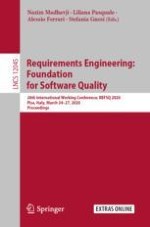2020 | Book
Requirements Engineering: Foundation for Software Quality
26th International Working Conference, REFSQ 2020, Pisa, Italy, March 24–27, 2020, Proceedings
Editors: Nazim Madhavji, Liliana Pasquale, Ph.D. Alessio Ferrari, Stefania Gnesi
Publisher: Springer International Publishing
Book Series : Lecture Notes in Computer Science
